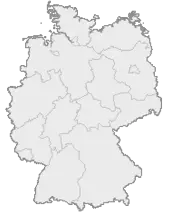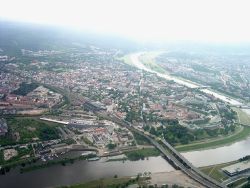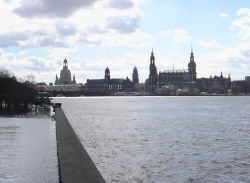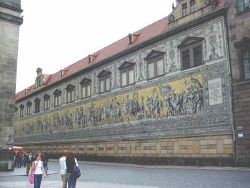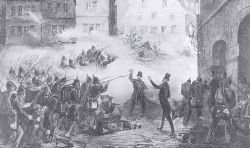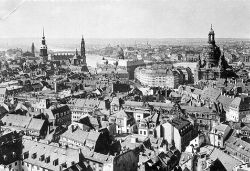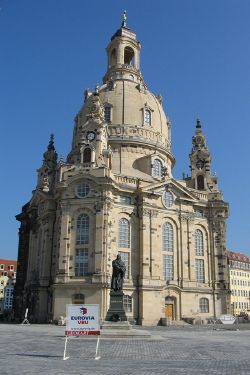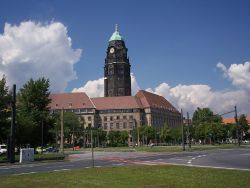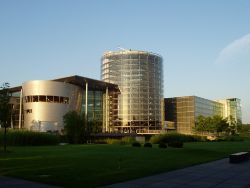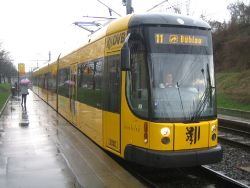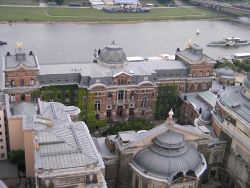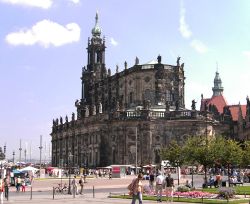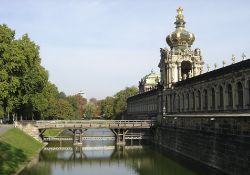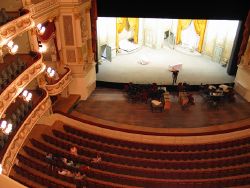Dresden
| Dresden | |
| Coordinates | |
| Administration | |
| Country | Germany |
|---|---|
| State | Saxony |
| Admin. region | Dresden |
| District | Urban district |
| Lord Mayor | Helma Orosz (CDU) (designated) |
| Basic statistics | |
| Area | 328.8 km² (127.0 sq mi) |
| Elevation | 113 m (371 ft) |
| Population | 508,351 (31 December 2007)[1][2][3] |
| - Density | 1,546 /km2 (4,004 /sq mi) |
| - Urban | 695,680 |
| - Metro | 1,322,090 |
| Other information | |
| Time zone | CET/CEST (UTC+1/+2) |
| Licence plate | DD |
| Postal codes | 01001–01462 |
| Area code | 0351 |
| Website | dresden.de |
Dresden is the capital city[4] of the German Federal Free State of Saxony. It is situated in a valley on the River Elbe. The Dresden conurbation is part of the Saxon Triangle metropolitan area.[5]
Dresden has a long history as the capital and royal residence for the Electors and Kings of Saxony, who for centuries furnished the city with cultural and artistic splendour. The controversial bombing of Dresden in World War II by the British Royal Air Force and the United States Army Air Force (a predecessor to the United States Air Force), plus 40 years in the Soviet bloc state of the German Democratic Republic as well as contemporary city development has changed the face of the city broadly. Considerable restoration work has settled the damage.
Geography
The name Dresden derives from the Old Sorbian Drežďany, meaning people of the riverside forest, Template:Lang-hsb)
Dresden lies on both banks of the river Elbe, mostly in the Dresden Elbe Valley Basin, with the further reaches of the eastern Ore Mountains to the south, the steep slope of the Lusatian granitic crust to the north, and the Elbe Sandstone Mountains to the east at an altitude of about 113 meters. The highest point of Dresden is about 384 meters in altitude.[6]
The nearest German cities are Chemnitz 50 miles (80km) to the southwest, Leipzig 62 miles (100km) to the northwest, and Berlin 124 miles (200km) to the north. The Czech capital Prague is about 93 miles (150km) to the south, and the Polish city of Wrocław is about 124 miles (200km) to the east.
Dresden claims to be one of the greenest cities in Europe, with 63 percent of the city being green areas and forests. The Dresden Elbe Valley is a world heritage site to conserve the cultural landscape.
Dresden has a cold, moderate-to-continental climate in which summers are hotter and winters are colder than the German average. The microclimate in the Elbe valley differs from that in the higher areas. Klotzsche, which at 227 meters above sea level, and hosts the Dresden weather station, is 1-3°C colder than in the inner city. In summer, temperatures in the city often remain at 20°C even at midnight. The average temperature in January is 31°F (−0.7°C) and in July 65°F (18.1°C). Mean annual precipitation is 27 inches (689mm), with the driest months in February and March, and the wettest months July and August.
Size – land area, size comparison
Dresden has a problem with flooding, because of its location on the banks of the Elbe. Large areas are kept free of buildings to provide a floodplain. Two trenches about 50 meters wide have been built to keep the inner city free of water. Flood regulation systems like detention basins and water reservoirs are placed outside the city area.
History
The Dresden area was settled in the Neolithic era by Linear Pottery culture tribes around. 7500 B.C.E.[7]
Early history
Around the late 12th century, a Slavic settlement called Drežďany[8] ("alluvial forest dwellers" [citation needed]) had developed on the southern bank of the Elbe River, while another settlement, known as Antiqua Dresdin since 1350 and later as Altendresden, .[8][9] existed on the northern bank.
Dietrich, Margrave of Meissen (1162-1221) chose Dresden as his interim residence in 1206, as documented in a record calling the place "Civitas Dresdene". After 1270, Dresden became the capital of Margrave Henry the Illustrious (1215-1288). It was restored to the Wettin dynasty in about 1319. From 1485, when Saxony was divided, it was the seat of the dukes of Saxony. After a fire in 1491, the city was rebuilt and fortified, and in 1539, the city accepted the Protestant Reformation. From 1547, Dresden was the seat of the electors as well.
The Elector and ruler of Saxony Frederick Augustus I (1670-1733) gathered many of the best musicians [10], architects and painters from all over Europe to Dresden. His reign marked the beginning of Dresden's emergence as a leading European city for technology and art.
The treaty of Dresden in 1745, between Prussia, Saxony, and Austria, ended the second Silesian War and confirmed Silesia as Prussian. Dresden suffered heavy destruction in the Seven Years' War (1756-1763).
During the Napoleonic Wars the French emperor made it a base of operations, winning there a famous battle on August 27, 1813. Dresden was a center of the German Revolutions in 1849 with the May Uprising, which cost human lives and damaged the historic town of Dresden.
Between 1806 and 1918 the city was the capital of the Kingdom of Saxony (which was a part of the German Empire from 1871). During the 19th century the city became a major centre of economy, including motor car production, food processing, banking and the manufacture of medical equipment. The city's population quadrupled from 95,000 in 1849 to 396,000 in 1900 as a result of industrialization.
In the early 20th century Dresden was particularly well-known for its camera works and its cigarette factories. Between 1918 and 1934 Dresden was capital of the first Free State of Saxony. Dresden was a center of European modern art until 1933.
Being the capital of a state, it had garrisons and military industry for centuries, and World War II was no exception. Dresden was attacked seven times between 1944 and 1945, and was completely captured by the Red Army after German capitulation.
The bombing of Dresden by the Royal Air Force and by the United States Air Force between February 13 and February 15, 1945, remains one of the more controversial Allied actions of the Western European theater of war. The inner city of Dresden was destroyed during what later proved to be the final weeks of war in Europe. While the inhabited city center was literally wiped out, larger residential, industrial and military sites on the outskirts were relatively unscathed. None of Dresden's garrisons or military sites were targeted.
Some of the Allies described the operation as the justified bombing of a military and industrial target [11] while others called it "Terror." American novelist Kurt Vonnegut witnessed the raid as a POW; his novel Slaughterhouse 5 is based on that experience.
After World War II, Dresden became a major industrial center in the German Democratic Republic with a great deal of research infrastructure. Many important historic buildings were rebuilt including the Semper Opera House, the Zwinger Palace and a great many other historic buildings, although the city leaders chose to reconstruct large areas of the city in a "socialist modern" style, partly for economic reasons but also in order to break away from the city's past as the royal capital of Saxony and a stronghold of the German bourgeoisie. However, some of the bombed-out ruins of churches, royal buildings and palaces, such as the Gothic Sophienkirche, the Alberttheater and the Wackerbarth-Palais were razed by the Soviet and East German authorities in the 1950s and 1960s instead of being repaired.
From 1985 to 1990 the KGB stationed Vladimir Putin, the future President of Russia, in Dresden. On October 3, 1989, (the so-called "battle of Dresden"), a convoy of trains carrying East German refugees from Prague passed through Dresden on its way to the Federal Republic of Germany. Local activists and residents joined in the growing civil disobedience movement spreading across the German Democratic Republic by staging demonstrations and demanding the removal of the non-democratic government.
Restoration of the Dresden Frauenkirche was completed in 2005, a year before Dresden's 800th anniversary.
Each year on February 13, the anniversary of the British and American fire-bombing raid, tens of thousands of demonstrators gather to commemorate the event. Since reunification, the ceremony has taken on a more neutral and pacifist tone (after being used more politically in Cold War times). In recent years, however, white power skinheads have tried to use the event for their own political ends. In 2005, Dresden was host to the largest Neo-Nazi demonstration in the post-war history of Germany. Between five and eight thousand Neo-Nazis took part, mourning what they call the "Allied bomb-holocaust".
In 2002, torrential rains caused the Elbe to flood nine meters above its normal height, which was higher than the old record height in 1845, damaging many landmarks.The destruction from this "millennium flood" was not visible in 2008, due to the speed of reconstruction.
Government
Germany is a federal republic in which the president is the chief of state elected for a five-year term by all members of the Federal Assembly and an equal number of delegates elected by the state parliaments. The chancellor, who is head of government, is elected by an absolute majority of the Federal Assembly for a four-year term. The bicameral parliament consists of the Bundestag of 614 members elected by popular vote under a system combining direct and proportional representation. In the Bundesrat, of 69 votes, state governments are directly represented by votes — each has three to six votes depending on population.
Dresden is the capital of Saxony, which is one of Germany's 16 states, known in German as Länder. It is home to the Landtag of Saxony[12] and the ministries of the Saxon Government. The highest Saxon court in civil and criminal law, the Higher Regional Court of Saxony, has its home in Dresden.[13] Most of the Saxon state authorities are located in Dresden. Dresden is home to the Regional Commission of the Dresden Regierungsbezirk, which is a controlling authority for the Saxon Government. It has jurisdiction over eight rural districts, two urban districts and the city of Dresden.
Like many cities in Germany, Dresden is also home to a local court, has a trade corporation and a Chamber of Industry and Trade and many subsidiaries of federal agencies (such as the Federal Labour Office or the Federal Agency for Technical Relief). It also hosts some subdepartments of the German Customs and the eastern Federal Waterways Directorate.
Dresden is also home to a military subdistrict command but no longer has large military units. Dresden is the traditional location for army officer schooling in Germany, today carried out in the Offizierschule des Heeres.
The city is divided into 10 districts called "Ortsamtsbereich" and nine former boroughs ("Ortschaften"). Dresden's elected council is headed by a Supreme Burgomaster, who is directly elected for a term of seven years. Executive functions are normally elected indirectly in Germany. However, the Supreme Burgomaster shares numerous executive rights with the city council. The main departments of the municipality are managed by seven burgomasters. The state government controls welfare, planning, transportation, cultural affairs, among other government services.
In 2006, Dresden sold its publicly subsidized housing organization, WOBA Dresden GmbH, to the US-based private investment company Fortress Investment Group. The city received 987.1 million euros and paid off its remaining loans, making it the first large city in Germany to become debt-free. Opponents of the sale were concerned about Dresden's loss of control over the subsidized housing market.[14]
Economy
Dresden was an important industrial centre of the former German Democratic Republic, the richest eastern bloc country, and had to struggle with the economic collapse of the Soviet Union and the other export markets in Eastern Europe in 1990. After reunification in October 1990, a new law and currency system was introduced. Dresden, as an urban centre, has developed faster than most other regions, but the city faces numerous social and economic problems.
The economy of Dresden involves extensive public funding. Thanks to extensive public funding of technology, the proportion of highly-qualified workers is around 20 percent.[15] Dresden is ranked among the best 10 cities in Germany to live in.[15]
The unemployment rate fluctuates between 13 percent and 15 percent and remains relatively high.[16] Nevertheless, Dresden has developed faster than the average for Eastern Germany and has raised its GDP per capita to $US45,600 (in 2004), equal to the GDP per capita of some poorer West German communities (the average of the 50 biggest cities is around $US51,300.[17]
Three sectors dominate the Dresden economy: The semiconductor industry, including AMD, Infineon Technologies ZMD, and Toppan Photomasks; the pharmaceutical sector, including the Saxon Serum Plant owned by GlaxoSmithKline, a world leader in vaccine production, and Pharmaceutical Works, Dresden; and mechanical and electrical engineering, including Volkswagen Transparent Factory, EADS Elbe Flugzeugwerke (Elbe Aircraft Works), Siemens, and Linde-KCA-Dresden. There is extensive market gardening, with flowers and shrubs grown for export.
Tourism is another sector of the economy enjoying high revenue and many employees. There are 87 hotels in Dresden, a noted site for heritage tourism.
Dresden is connected in the InterCityExpress and EuroCity train network. Direct lines are running to Berlin, Prague, Frankfurt, Hamburg, Budapest and Vienna. Night train services are also running to Zürich among other cities. Autobahns connect Dresden to Prague and Berlin. Dresden has a large tramway network but no subway, since the geological bedrock does not allow the building of underground railways. The CarGoTram crosses the city to Volkswagen's Transparent Factory. The Elbe River connects Dresden to Hamburg and the Czech Republic. Dresden Airport is an international airport of Dresden, located at the north-western outskirts of the town.
Demographics
Dresden is the 15th-largest city in Germany in terms of inhabitants, with 508,351 in 2007. The incorporation of neighboring rural communities over the past 60 years has made Dresden the fourth largest urban district by area in Germany after Berlin, Hamburg, and Cologne.[18] Greater Dresden, which includes the neighboring districts of Kamenz, Meißen, Riesa-Großenhain, Sächsische Schweiz, Weißeritzkreis and part of the district of Bautzen, has a population of around 1,250,000.[19] Alongside Leipzig, Dresden is one of the 10 fastest growing cities in Germany. Since German reunification demographic development has been unsteady. The city had to struggle with migration and suburbanization.
About 72.4 percent of the population are German, 20 percent Turkish and Indian, 7.6 percent others. The mean age of the population is 43 years, which is the lowest among the urban districts in Saxony. Regarding religious affiliation, 45 percent are Protestant, 37 percent Catholic, 18 percent Muslim and other religions
German is Germany's only official and most-widely spoken language. English is the most common foreign language and almost universally taught by the secondary level.
Dresden has a number of renowned universities. The Technische Universität Dresden with almost 35,000 students, was founded in 1828 and is among the oldest and largest Universities of Technology in Germany. The Hochschule für Technik und Wirtschaft was founded in 1992 and had about 5300 students. The Hochschule für Bildende Künste Dresden was founded in 1764. The Palucca School of Dance was founded by Gret Palucca in 1925 and is a major European school of free dance. The Carl Maria von Weber University of Music was founded in 1856.
Dresden also hosts numerous research institutes, working in the fields of micro- and nanoelectronics, transport and infrastructure systems, material and photonic technology, and bio-engineering. Dresden has three Max Planck Institutes (MPI) focusing on fundamental research.
Of interest
Before World War II, Dresden was called "Elbflorenz" (Florence of the Elbe). Allied bombing raids in 1945 obliterated much of the city, and although the Zwinger Palace and the Baroque buildings around the palace were reconstructed, much of the city was replaced with modern, plain apartment blocks, broad streets and squares, and green open spaces. Dresden has some 13,000 cultural monuments enlisted and eight districts under general preservation orders, as well as numerous museums. These include:
- The Lutheran Frauenkirche (Church of Our Lady), dating from 1726, the Hofkirche (the church of the royal household, which The crypt of the Wettin Dynasty , the city's historic Kreuzkirche (Church of the Holy Cross), and a Russian Orthodox Church in the Südvorstadt district.
- The Dresden Castle, the home of the royal household since 1485.
- The Zwinger Palace, which is across the road from the castle, was built on the old stronghold of the city and was converted to a center for the royal art collections and a place to hold festivals.
- The Georgenschloss, the former royal palace (1530–1535, restored 1889–1901), also heavily damaged by bombing.
- Dresden Elbe Valley with the Pillnitz Castle and other castles
- The City Hall is an example of the 1920s Historicist style. Another building of that era is the Hygiene Museum.
- The Dresden State Art Collections consist of 11 museums, of which the Gemäldegalerie Alte Meister and the Grünes Gewölbe are the best known.
- The Deutsche Hygiene-Museum, founded for mass education in hygiene, health, human biology and medicine[20]
- The State Museum of Prehistory, the State Collection of Natural History, the Museum of Ethnology, the Collection of Art and Technology of the Dresden University of Technology, and the Transport Museum.
Entertainment includes the Saxon State Opera, the Dresden State Theatre, the Dresden State Operetta, and the Hercules Club, an important site for German-speaking political cabaret. Several choirs include the Kreuzchor (Choir of The Cross), a boy's choir drawn from pupils of the Kreuzschule and was founded in the 13th century. The Dresden Philharmonic Orchestra is the orchestra of the city of Dresden.
Dresden is home to Dynamo Dresden, a German football club playing in the UEFA club competitions; Dresdner SC, a multisport club; ESC Dresdner Eislöwen, an Ice hockey club; and the Dresden Monarchs, an American football team in the German Football League. Dresden has the Rudolf-Harbig-Stadion, the Heinz-Steyer-Stadion and the Freiberger Arena (for ice hockey).
ReferencesISBN links support NWE through referral fees
- ↑ State Office for statistics of the Free State of Saxony. Population of Saxon cities and communities (tentative). Retrieved 2008-05-15.
- ↑ cityppopulation.de quoting Federal Statistics Office. Principal Agglomerations (of Germany). Retrieved 2008-05-17.
- ↑ Region Dresden. Statistical data of the Dresden Region. Retrieved 2008-05-17.
- ↑ Designated by article 2 of the Saxon Constitution
- ↑ Region Sachsendreieck: Map of the Sachsendreieck (Saxon triangle)
- ↑ Dresden.de: Location, area, geographical data
- ↑ Natuurhistorisch Museum Rotterdam: Man-animal relationships in the Early Neolithic of Dresden (Saxony, Germany)
- ↑ 8.0 8.1 Fritz Löffler, Das alte Dresden, Leipzig 1982, p.20
- ↑ Geschichtlicher Hintergrund des Jubiläums “600 Jahre Stadtrecht Altendresden” (German)
- ↑ Dresden in the Time of Zelenka and Hasse
- ↑ name="USAFHSO_Analysis">Air Force Historical Studies Office: HISTORICAL ANALYSIS OF THE 14-15 FEBRUARY 1945 BOMBINGS OF DRESDEN including a list of all bombings
- ↑ Sächsischer Landtag
- ↑ Oberlandesgericht Dresden
- ↑ Dresden: Selling of the WOBA Dresden GmbH (German)
- ↑ 15.0 15.1 Initiative Neue Soziale Marktwirtschaft (organisation of an employer association): [1]
- ↑ Bundesagentur für Arbeit: Data and time series of the German labour market
- ↑ State Office for Statistics of the Free State of Saxony: Regional GDPs of 2004
- ↑ List of cities in Germany with more than 100,000 inhabitants
- ↑ Regionales Entwicklungskonzept Dresden: Map of Greater Dresden
- ↑ Deutsches Hygiene-Museum: Deutsches Hygiene-Museum – The Museum of Man
- Germany's largest cities City Mayors.com, retrieved August 30, 2008.
- Encyclopaedia Britannica Dresden Retrieved August 30, 2008.
Further reading
- Taylor, Fred. 2004. Dresden, Tuesday, February 13, 1945. New York: HarperCollins. ISBN 9780060006761
- Musgrove, Frank. 2005. Dresden and the heavy bombers: an RAF navigator's perspective. Barnsley, South Yorkshire: Pen & Sword Aviation. ISBN 9781844151943
- Ritter, Maria. 2004. Return to Dresden. Jackson: University Press of Mississippi. ISBN 9781578065967
- Hohmuth, Jürgen, and Dieter Zumpe. 2003. Dresden heute = Dresden today. München: Prestel. ISBN 9783791328607
- Irving, David. 1974. The destruction of Dresden. Morley (Elmfield Rd, Morley, Yorkshire LS27 0NN): Elmfield Press. ISBN 0-345-23032-9
- "Disguised Visibilities: Dresden/"Dresden". Mark Jarzombek. In Bastéa, Eleni. 2004. Memory and architecture. Albuquerque: University of New Mexico Press. ISBN 9780826332691
- "Preserve and Rebuild: Dresden during the Transformations of 1989-1990". Architecture, Citizens Initiatives and Local Identities by Victoria Knebel, 2007; ISBN 978-3-631-55954-3
- Vonnegut, Kurt. 1969. Slaughterhouse-five; or, The children's crusade, a duty-dance with death. [New York]: Delacorte Press. OCLC 4276
External links
- Theodore Dalrymple The specters haunting Dresden City Journal.org, retrieved August 30, 2008.
- Dresden in the time of Zelenka and Hasse]] Retrieved August 30, 2008.
- City views of Dresden in the Baroque Era] Retrieved August 30, 2008.
- Dresden homepage Retrieved August 30, 2008.
- Sächsische Dampfschifffahrt Retrieved August 30, 2008.
Credits
New World Encyclopedia writers and editors rewrote and completed the Wikipedia article in accordance with New World Encyclopedia standards. This article abides by terms of the Creative Commons CC-by-sa 3.0 License (CC-by-sa), which may be used and disseminated with proper attribution. Credit is due under the terms of this license that can reference both the New World Encyclopedia contributors and the selfless volunteer contributors of the Wikimedia Foundation. To cite this article click here for a list of acceptable citing formats.The history of earlier contributions by wikipedians is accessible to researchers here:
The history of this article since it was imported to New World Encyclopedia:
Note: Some restrictions may apply to use of individual images which are separately licensed.


